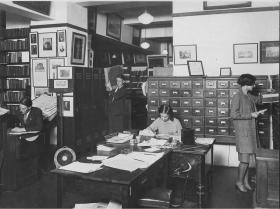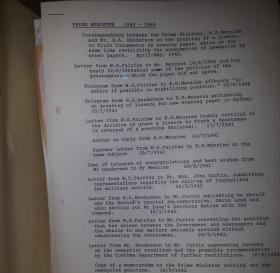So what are we doing with the Fairfax Business Archive?

The recently acquired Fairfax Media business archive tells the history of an iconic Australian Company. The archive itself has its own story and this story has a large bearing on how the archive will be arranged and described by staff at the State Library of New South Wales.
Many companies and businesses do not place enough emphasis on keeping or organising their business records and as a result there is little documentation on the growth and development of the company. Fortunately, the Fairfax company did value its past which is evident from how proudly the Sydney Morning Herald marked milestones in its history and growth. The company, guided no doubt by the Fairfax family's appreciation for the historical record, made an effort to keep records for their evidential and historic value, and in the process compiled an extensive company library and archive.
In the 1931 publication “A Century of Journalism” the author writes,
“It is believed that no newspaper library in the world is more complete than the Herald library… In the main library is housed a rare collection of Australian historical books and records (known to students of Australian history as the Fairfax Collection).”
The Fairfax library collection at that time perhaps focused more on preserving newspapers, books and indexes but amongst these were certainly business records. As the company grew to become a public listed company with a complex web of subsidiary companies carrying out diverse activities, so too did the volume of records the company created and were required to preserve. It became a task too great for the Fairfax library to manage.
The Fairfax company archive was established in 1974 with the appointment of the company’s first archivist, Eileen Dwyer, the private secretary to the Editorial Manager. Although not a trained archivist Eileen worked zealously to arrange the company’s archive, creating detailed listings of records grouped together by their creating office. Eileen retired in 1993 and was succeeded by Louise Preston who worked on the archives with equal determination. Together they created a 1500 page finding aid, which remained the primary finding aid for over 1400 boxes of archives.
For 10 years between 1996 and 2006 no archivist was employed at Fairfax. In 2006 Lyn Milton was employed as part-time Archivist to work through the unprocessed portion of the archive. After evaluating the record group system used by her predecessors she decided to draw a line where the old record group system ended and implemented a new “series system” to arrange and describe the archives. Instead of a typewriter and paper Lyn used Tabularium, a database created with Microsoft Access, to manage the data and she created series based on provenance, compiling administrative histories and biographies which were lacking from the earlier finding aids.
Through the introduction of the database two systems of control came into existence - the legacy "records" group system and the new "series" system. Files that would have previously continued as part of the original record group were now being put into new series with different identification numbers. In 2009, after describing hundreds of boxes of records, Milton’s contract with Fairfax ended with hundreds more boxes of records still waiting to be archived.
Nothing more was done with the records until November 2016 when the collection was transferred into the custody of the State Library of New South Wales. The size and complexity of the collection called for it to be treated as a project. The Fairfax Media Business Archive project plan consists of several phases.
The first phase focuses on those records arranged and described by previous Fairfax archivists. Consisting of approximately 1700 boxes, this component of the collection is controlled by the two major finding aids mentioned previously.
The first finding aid is a hard copy typed list of box contents grouped by creator, compiled between 1974-1996. Our goal was to take a digitised version of this finding aid, extract the data into spreadsheets, clean the data, and split it into appropriate fields. In many cases the box contents are extremely detailed, with extensive listings of individual items in a file together with contextual information.
The typed pages, however, lacked a consistent layout and with handwritten notes over the pages the task of extracting the data into a spreadsheet was a time-consuming task. Since the listings resembled box lists we also had to identify files within the listing and separate these into individual records. Over several months we extracted the digitised descriptions into spreadsheets, restructured the data into series, sub-series and file level descriptions and created basic fields such as title, scope and content, data range and notes. Spelling and comprehensibility was also checked as errors occured in the optical character recognition process. The aim was to have all the data in the finding aid transferred into spreadsheets for the next phase of the project which involved verifying the physical contents of the boxes with the lists.

Once the spreadsheets are created we physically inspect every box, verifying the contents against the spreadsheets to ensure the data is correct. If necessary additional data is added to the spreadsheet. We attempt to keep the original order imposed by the former archivists and to verify the data against the physical record, restructure and add data where necessary. New library call numbers are allocated with the original Fairfax record identification numbers retained. Only essential preservation interventions are carried out, usually the replacement of boxes, removal of rusty metal fasteners, folder replacements, treatment for mould etc.
The second finding aid, the Access database, will continue to be used, with slight modifications, to verify and update descriptive data of files in the system until we are ready to migrate it into the Library’s system. It should be noted that the original finding aids will form part of the collection.
An additional phase of the project involved returning to the Fairfax Media warehouse to appraise a further 700-800 boxes of unlisted, unlabelled company records. A team of four librarians from the library selected an additional 400 boxes to be added to the collection already at the Library. These records will be described and rehoused, but the challenge will be making decisions as to where these files fit in the two existing systems of arrangement.
The final phase of the project will be to ensure the data in the spreadsheets is prepared and structured correctly for importing into the Library’s collection management system. We aim to have the project completed by early 2018.
Author
Peter Arfanis, Project Lead, State Library of New South Wales, 2017